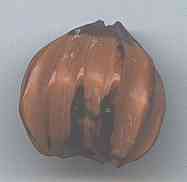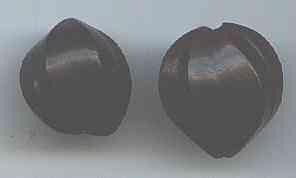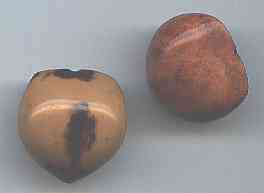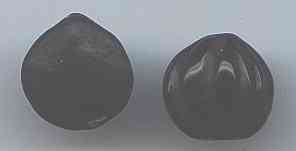The Bead Site Home>Beadmaking & Materials>Organic Materials> Kukui
|
|
The Wonderful Kukui Tree
The Kukui or Candlenut tree (Aleurites moluccana L.) is the state tree of Hawai'i and the symbol of the `Aha Kupuna, the Council of Elders of the Nation of Hawai`i. Native to Southeast Asia, it was apparently brought to the islands by early Polynesian settlers.
|
The beautiful silvery-green leafed tree (click here for more images of the tree by Dr. Carr of the University of Hawai'i) provides shade and many products (see below). The use that gave it the name of "candlenut tree" was to string the husked nuts up a palm frond rib. Then they would be lit from top to bottom (often the duty of the children) to give light into the night.
|
Some Uses of the Kukui Tree:
(Note: Tapa is a local cloth madefrom the bark of the paper mulberry, breadfruit, and other trees)
Nut Husks: Pierced, sometimes carved and worn in traditional leis (garlands) or carved into pendants. They have also been mounted in gold and used in finer jewelry.
Nuts:
1. Medicinal: Strong purgative. In combination with other plants, used to treat skin ulcers, rheumatic joints, and deep bruises and wounds. There is some evidence that small amounts of the roasted nut reduce blood pressure.
2. Food: The nut is slightly poisonous, but the toxin is removed by roasting. Small amounts of the roasted, chopped nuts are flavored with salt and sometimes chili peppers and eaten as the condiment Inamona.
3. Soot from burned nut: Used to dye tapa, for tattoos, and to stain surfboards.
4. Crushed roasted kernels: Spread out on the sea surface, allow one to peer into the deep, as it acts like a lens. The Hawai'ian proverb "When the kukui nut is spat on the water, the sea is smooth" is equivalent to "pouring oil on troubled waters."
5. Oil extracted: Used to varnish and preserve wood, to waterproof fishing nets and paper, as a paint oil, in soapmaking, as a substitute for rubber products, and as an insulating material. In the early 19th century up to as 10,000 gallons (37,850 l) were exported, principally to the Russians in Alaska as a substitute for linseed oil.
6. Burned for illumination: On a palm leaf rib, as mentioned above, but also in stone lamps and torches.
Flowers: Strung into garlands. Parents chew the white flowers to use to heal mouth sores (thrush) of children.
Leaves: Strung into garlands representing Moloka'I, whose color is silvery green.
Sap: Used for moth sores, chapped lips, cold sores, and mild sunburns. Also a strong purgative.
Inner bark: Yields a dark red dye used for tapa and fishnets; tannin in the dye strengthens nets and preserves them.
Gum: Strengthens tapa. The Hawai'ian proverb "The gum sticks to the candlenut tree" refers to a parasite or a child clinging to its mother.
Trunk: Made into canoes and fishing net weights.
Is it any wonder the Polynesians brought it along?
Thanks go to:
Barbara Farrell for information and samples
and to the following web pages for further information:
http://www.hawaii-nation.org/canoe/kukui.html
http://www.geobop.com/World/NA/US/HI/Tree.htm
http://apdl.kcc.hawaii.edu/~ahupuaa/botany/other/kukui.htm
http://www.huapala.org/Lei_Kukui.html
http://www.botany.hawaii.edu/faculty/bridges/leiday/default.htm
The 72nd Annual Lei Day Competition (1999). Kukui was often used.
Slow to download, but interesting pictures.
_______________________________________________
Small Bead Businesses | Beading & Beadwork | Ancient Beads | Trade Beads
Beadmaking & Materials | Bead Uses | Researching Beads | Beads and People
Center for Bead Research | Book Store | Free Store | Bead Bazaar
Shopping Mall | The Bead Auction | Galleries | People | Events
The Bead Site Home | Chat Line | Contact Us | Site Search Engine | FAQ




